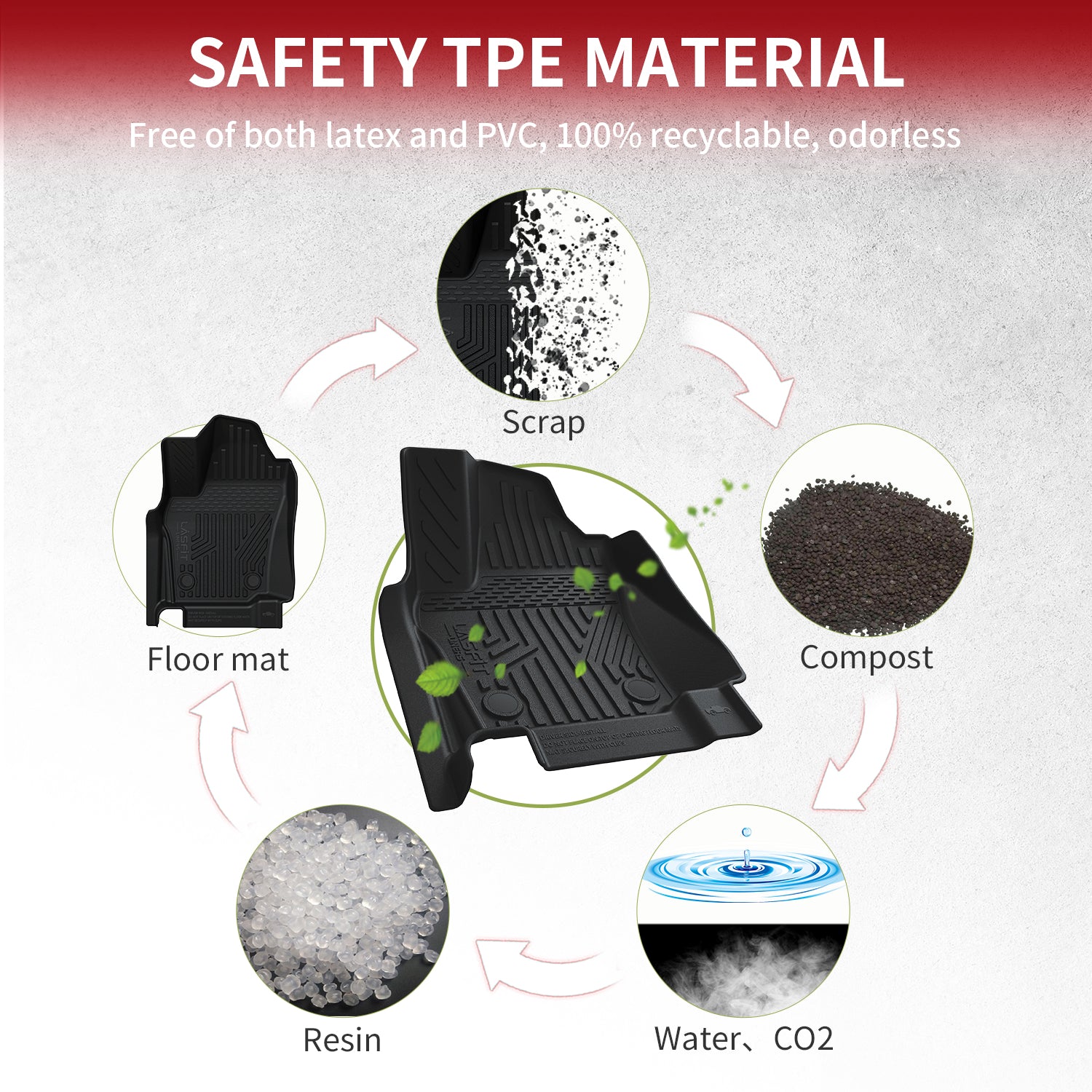The choice between Thermoplastic Elastomer (TPE) and rubber floor mats is more than a matter of durability or aesthetics—it’s a decision that impacts the planet. As climate concerns grow, drivers are demanding products that protect both their vehicles and the environment. Let’s dive into why TPE mats are winning the sustainability race, backed by science, certifications, and real-world impact.
1. The Environmental Cost of Rubber Mats
Rubber, a staple in automotive accessories for decades, hides a dirty secret: its production and disposal are ecological disasters.
Problem 1: Fossil Fuel Dependency
- Petroleum-Based: Over 80% of synthetic rubber is derived from non-renewable crude oil.
- Energy-Intensive Production: Vulcanization—a process requiring temperatures above 300°C—consumes 40% more energy than TPE manufacturing.
- Carbon Footprint: Producing one set of rubber mats emits 8.1 kg of CO₂, equivalent to driving a gas-powered car for 32 miles.
Problem 2: Toxic Legacy
- Chemical Leaching: Rubber breaks down over time, releasing microplastics and toxic additives like cadmium and sulfur compounds into soil and waterways.
- Landfill Lifespan: A single rubber mat takes 450+ years to decompose, contributing to the 200 million mats clogging landfills annually.
2. TPE: The Science of Sustainable Innovation
TPE combines the flexibility of rubber with the recyclability of plastics. Lasfit’s TPE mats go further, certified by the Global Recycled Standard (GRS) Level 3—the gold standard for sustainability.
Why GRS Certification Matters
- 70%+ Recycled TPE Granules: Our TPE floor mats begin with certified recycled TPE granules—a premium raw material blend that gives new life to industrial and consumer waste.
- Zero Toxins: Free from 200+ harmful chemicals, including BPA, phthalates, and PFAS.
- Ethical Production: Factories undergo annual audits for fair wages and safe working conditions.
Carbon-Neutral Manufacturing
- Renewable Energy: Production facilities run on 100% solar and wind power, slashing CO₂ emissions by 82% vs. rubber.
- Water Efficiency: Closed-loop systems save 12,000 liters of water per ton of TPE produced.
- Zero Waste: 99.2% of manufacturing scraps are reused or donated to upcycling programs.
3. Lifecycle Analysis: TPE’s Circular Advantage
Let’s compare TPE and rubber across three phases:
| Phase | TPE Mats (GRS Certified) | Rubber Mats |
| Production | 2.8 kg CO₂ • 70% recycled content | 8.1 kg CO₂ • 100% virgin materials |
| Usage | 5–7 years • UV/ozone resistant | 2–3 years • Cracks in cold weather |
| End-of-Life | Fully recyclable via standard PE streams | 95% landfilled • 450-year decay |
Real-World Impact:
A 2024 fleet study showed that switching to TPE mats:
- Reduced annual plastic waste by 4.3 tons per 1,000 vehicles.
- Lowered carbon emissions by 12%, equal to planting 1,200 trees.
- Saved $8,200 in replacement costs over five years.
4. Busting Myths: TPE Outperforms Rubber
Critics claim eco-friendly means weaker—data proves otherwise:
Durability
- Tensile Strength: TPE withstands 22 MPa stress vs. rubber’s 15 MPa.
- Temperature Resistance: Flexible at -40°C, warp-free up to 120°C.
- Weight: 30% lighter than rubber, reducing fuel consumption.
Safety
- Non-Toxic: Passes California Prop 65 and EU REACH standards—safe for pets and kids.
- Anti-Slip Grip: Maintains 95% traction when wet, compared to rubber’s 70%.
Case Study:
“After three Minnesota winters, my Lasfit TPE mats still look new. My old rubber mats cracked within a year.” – Mark T., Truck Owner
5. How to Make the Sustainable Switch
- Check Certifications: Look for GRS, OEKO-TEX®, or USDA BioPreferred® labels.
- Recycle Responsibly: Use tools like Earth911 to find local TPE recyclers.
- Choose Wisely:
- For Families: Opt for antimicrobial TPE mats (prevents mold growth).
- For Extreme Weather: Select deep-channel designs (-50°C rated).
The Bigger Picture: Your Choice Shapes the Future
Every year, the automotive industry generates 9 million tons of plastic waste. By choosing GRS-certified TPE mats, you:
✅ Reduce reliance on fossil fuels
✅ Support ethical labor practices
✅ Prevent microplastic pollution
This isn’t just about floor mats—it’s about accelerating the shift to a circular economy where materials are reused, not wasted.
Act Now:
Explore Lasfit’s GRS-Certified TPE Floor Mats Collection and join thousands of drivers proving that sustainability and performance can coexist.





